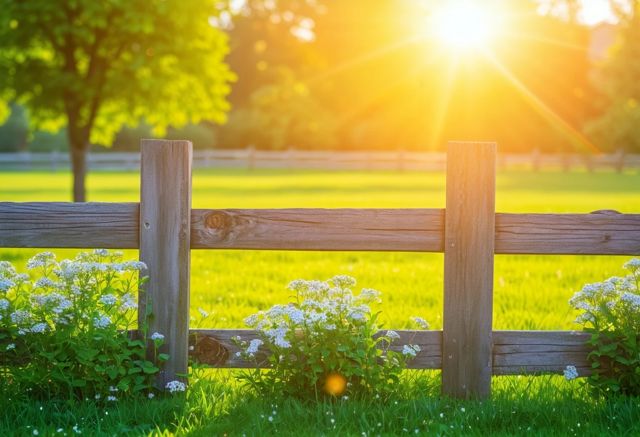To choose the right wood for fencing, consider factors like durability, such as hardwoods for long-lasting resilience or cedar for natural decay resistance. Balancing aesthetics, cost, and maintenance will ensure a practical and visually appealing choice.
Understanding Wood Durability
Explore the various types of wood and their unique properties to determine the best option for your fencing needs. Understanding the durability of wood is key, as factors like grain, hardness, and density play significant roles in its longevity and resistance to wear.
Types of Wood
Hardwoods (from deciduous trees):
- Oak: Strong and moisture-resistant, ideal for durable fencing.
- Maple: Light-colored with a uniform grain, good for aesthetic appeal.
- Mahogany: Reddish-brown and durable, often used in high-quality projects.
- Walnut: Rich color and distinctive grain, adds a decorative touch.
- Cherry: Warm reddish hue, ages well, used for premium projects.
Softwoods (from evergreen trees):
- Pine: Affordable and commonly used, requires treatment to prevent warping.
- Cedar: Naturally resistant to decay and insects, perfect for outdoor use. Read more about top wood fence styles for 2024.
- Spruce and Fir: Common for structural applications.
- Redwood: Durable and attractive, ideal for outdoor furniture and fencing.
Key Characteristics
- Strength: Ensure the wood can withstand weight and pressure.
- Density: Heavier woods are generally stronger and more durable.
- Appearance: Choose a grain pattern and color that matches your design.
Factors to Consider
- Budget: – Softwoods like pine and cedar are generally more affordable. – Hardwoods like oak and maple can be more expensive but offer greater durability.
- Aesthetics: – Consider how the wood will fit with your overall design. – Take into account how the wood’s appearance will change over time.
- Durability: – Hardwoods tend to be more resistant to scratches and wear. – Cedar and redwood are excellent choices for resisting outdoor elements.
- Environmental Concerns: – Choose wood from sustainably managed forests. – Reclaimed wood is another eco-friendly option.
Selection Process
- Use: Determine if the wood is for fencing, furniture, or another purpose.
- Type: Decide between hardwood or softwood based on your needs.
- Characteristics: Select based on grain, color, and texture.
- Budget: Balance cost with the expected longevity.
- Sustainability: Opt for eco-friendly choices.
- Inspection: Check the wood for any defects or imperfections.
- Origin: Ask about where and how the wood was processed.
Selecting the right wood ensures a balance between visual appeal, durability, budget, and sustainability, ultimately leading to long-lasting and attractive fencing solutions.

Weather Resistance of Various Woods
When choosing wood for fencing, considering weather resistance is essential. Different woods have varying degrees of durability against the elements, rot resistance, and insect susceptibility. Here’s a breakdown:
- Cedar: Excellent rot resistance and natural oils that repel insects. Performs well in moist environments.
- Redwood: Highly resistant to rot and insects. Ideal for settings with high moisture levels.
- Pressure-treated Pine: Enhanced durability due to chemical treatment. Good for resisting both rot and insects but may require more maintenance.
- Cypress: Contains a natural preservative called cypressene, offering great rot and insect resistance. Suitable for humid conditions.
Proper maintenance and sealing can extend the lifespan of wood fences, ensuring they withstand various weather conditions effectively.
Appearance and Aesthetic Qualities
When selecting wood for fencing, it’s vital to consider its appearance and how it aligns with your property’s look. Different woods offer unique visual characteristics, making some more suited to certain styles than others.
- Color: Wood comes in a variety of colors ranging from light pines to rich walnuts. Choose a color that complements the exterior of your property.
- Grain Patterns: The grain pattern adds to the texture and feel of the wood. Tight grains offer a smoother look, while wide grains provide a rustic appearance.
- Aging: Over time, the appearance of wood can change. Some woods darken, while others may lighten or develop a natural patina. Consider how the wood will look as it ages.
Understanding these qualities will help you select a wood that meets your aesthetic preferences and maintains its visual appeal over time.

Cost and Maintenance Considerations
When selecting wood for your fence, consider both cost and maintenance to ensure your investment lasts. Different wood types come with varying price points and upkeep needs.
Cost Considerations
- Hardwoods: More expensive due to their density and durability. Common types include mahogany, maple, and oak.
- Softwoods: Generally more affordable. Cedar, Douglas fir, and pine are popular for their cost-effectiveness.
- Engineered Woods: Budget-friendly options like plywood and MDF. These are less durable but feasible for certain fence sections.
Maintenance Requirements
- Pressure-Treated Wood: Resistant to weathering but requires regular sealing to prevent moisture damage.
- Cedar: Naturally resists mold, mildew, and insects due to its oils. Minimal maintenance is needed.
- Hardwoods: Typically more durable and weather-resistant but require periodic sealing and treatments to maintain their look and strength.
Long-Term Investment
- Durability: Hardwoods last longer but come with a higher upfront cost.
- Ease of Maintenance: Softwoods like cedar offer a balance of lower cost and ease of upkeep.
For expert craftsmanship and customized fencing solutions, explore Pickets Wood Fences.

FAQ
What factors determine the durability of wood for fencing?
The durability of wood for fencing is determined by factors such as grain, hardness, and density. These characteristics play significant roles in its longevity and resistance to wear.
What are the common types of hardwoods used for fencing?
Common types of hardwoods used for fencing include oak, maple, mahogany, walnut, and cherry. Each type has unique properties that contribute to its strength and aesthetic appeal.
What are the common types of softwoods used for fencing?
Common types of softwoods used for fencing include pine, cedar, spruce, fir, and redwood. These woods are known for their affordability and resistance to outdoor elements.
What are the key characteristics to look for when choosing wood for fencing?
When choosing wood for fencing, consider its strength, density, and appearance. Ensure the wood can withstand weight and pressure, and choose a grain pattern and color that matches your design.
How does budget impact the choice of wood for fencing?
Your budget can impact whether you choose hardwoods or softwoods. Softwoods like pine and cedar are more affordable, while hardwoods like oak and maple, which offer greater durability, can be more expensive.
Which woods are best for resisting outdoor elements?
Cedar and redwood are excellent choices for resisting outdoor elements like moisture and insects. Hardwoods also offer good resistance to scratches and wear.
What should I consider regarding the appearance of wood over time?
Consider how the wood’s appearance will change over time. Some woods may darken, lighten, or develop a natural patina. Choose a wood that meets your long-term aesthetic preferences.
How can I ensure the wood I choose is environmentally friendly?
To ensure the wood is environmentally friendly, choose wood from sustainably managed forests or opt for reclaimed wood. This supports eco-friendly practices.
What woods have excellent weather resistance for fencing?
Cedar, redwood, pressure-treated pine, and cypress offer excellent weather resistance. Cedar and redwood are naturally resistant to rot and insects, while pressure-treated pine and cypress are treated to enhance durability.
How does maintenance affect the longevity of a wood fence?
Proper maintenance and sealing are essential to extend the lifespan of a wood fence. Regular maintenance can ensure the wood withstands various weather conditions effectively.
What are the cost differences between hardwoods and softwoods for fencing?
Hardwoods like mahogany, maple, and oak are more expensive due to their density and durability. Softwoods like cedar, Douglas fir, and pine are generally more affordable.
What maintenance is required for different types of wood used in fencing?
Pressure-treated wood requires regular sealing to prevent moisture damage. Cedar is naturally resistant to mold and insects, requiring minimal maintenance. Hardwoods require periodic sealing and treatments to maintain their look and strength.

